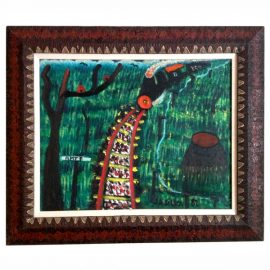Antonio de Olinda
Comments Off on Antonio de OlindaAntonio de Olinda was born in 1966 as Antonio José dos Santos, the youngest of nine siblings. He grew up in Olinda a small town on the northeast coast of Brazil. Inspired by the surrounding rich culture and nature, Olinda began artmaking at a young age. He was introduced to craft and storytelling when he started working at Mamulengo, a well-known puppet theatre in Pernambuco, East Brazil. He also worked as an assistant to the painter, Roberto Lúcio.
In 1984, Olinda participated in a group exhibition, marking the beginning of his career as an artist. Three years later, he received a prestigious award from the Salão das Artes de Pernambuco. He has been exhibited in numerous galleries and museums, including the Museum of Contemporary Art in Olinda and Jacques Ardies Gallery in Sao Paulo. Through the energetic use of vibrant colors and expressive brush strokes, Olinda depicts the social chronicle and popular culture of his beloved native land.
While working as a painter, Olinda continued in theatre and film as a Mamulengueiro, puppeteer, carnival artist, cultural producer, scenographer, and art director. Notably, Olinda created props for the scenography of the films Baile Perfumado (1996) by Lírio Ferreira and Paulo Caldas, an icon of the revival of Pernambuco cinema. Furthermore, he directed the short films Cultura popular da Ilha ao Continente (2005) and Maria do samba (2009), in addition to heading the art of O homem da mata (2004).
Olinda died from kidney failure in 2015. Though his life was short, the joy and vitality of his work continue to inspire people around the world.

